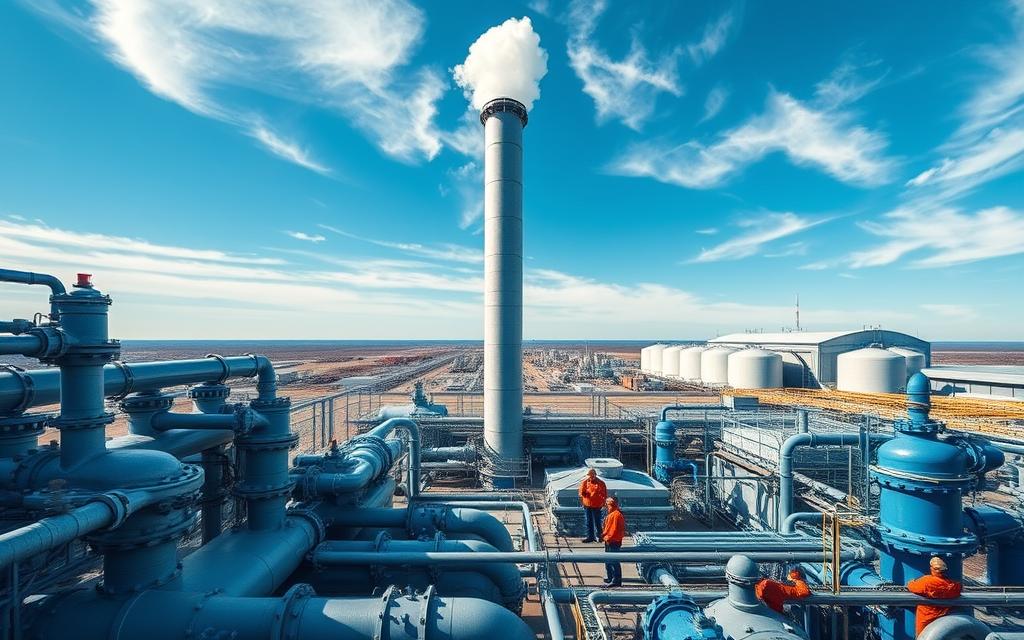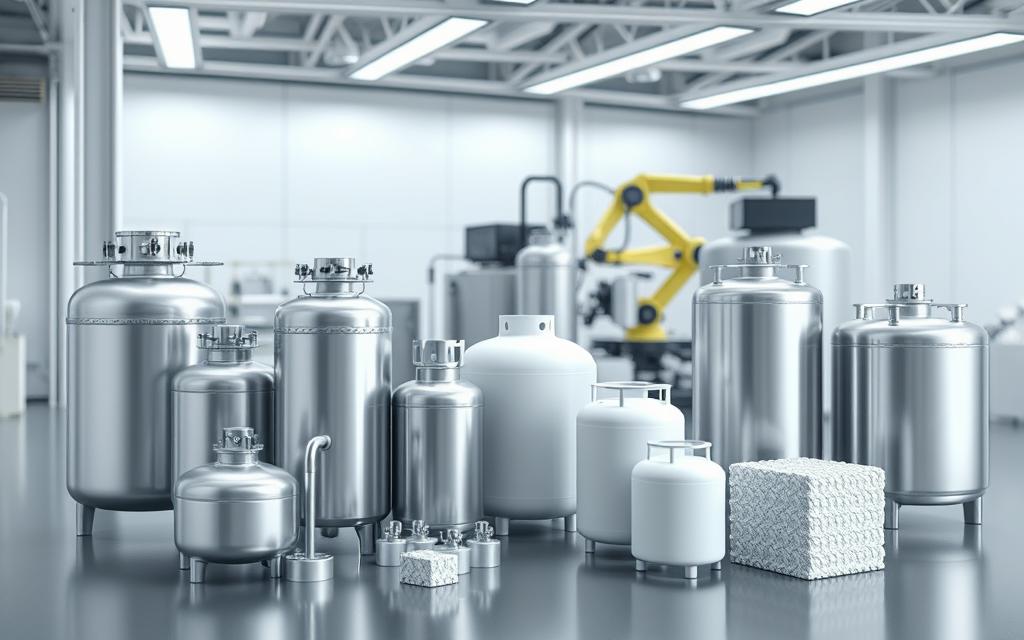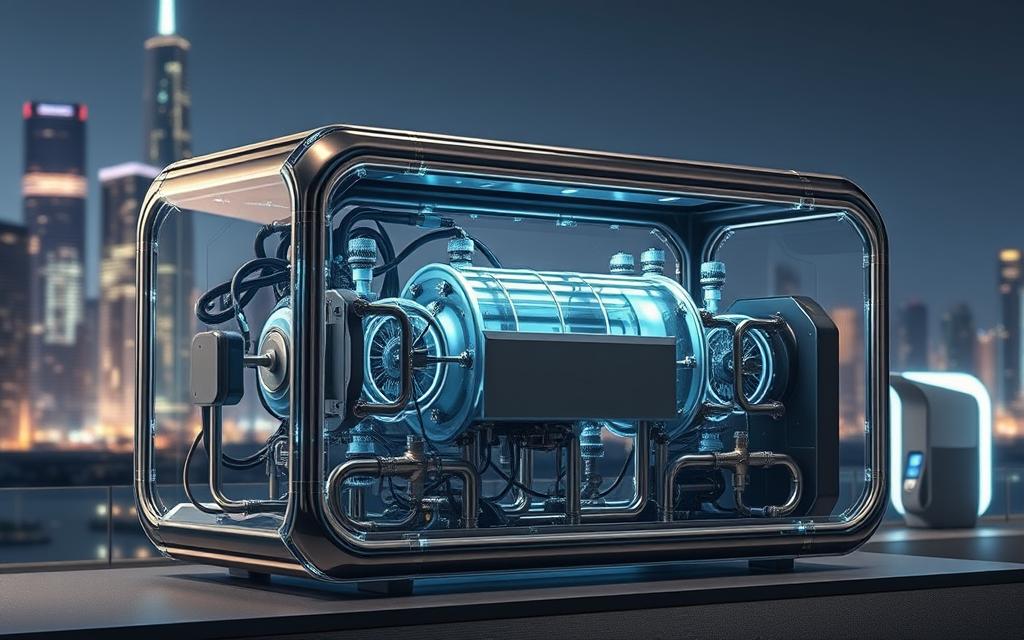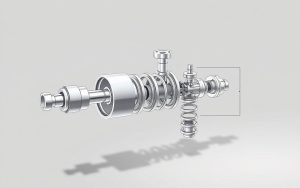As the world works to cut down carbon emissions, low-carbon hydrogen is key in the clean energy transition. Blue hydrogen is a smart choice between old fossil fuels and new, green systems. It’s a bridge to a cleaner future.
Blue hydrogen is made by mixing steam with methane and capturing carbon. This method cuts emissions by 60-90% compared to old ways. It uses current gas systems but captures carbon, making it good for big industries like shipping and heavy manufacturing.
The International Maritime Organisation’s new rules show blue hydrogen’s importance in fighting global warming. Big names like GE Vernova have made turbines that can run on hydrogen blends. This shows how we can make old systems work with new fuels.
Green hydrogen is the dream, made from solar or wind power. But blue hydrogen is a quick fix. It can grow fast using old supply chains. This helps meet short-term goals while we build up new, green systems.
Defining Blue Gas Technology
Blue gas technology is a key link between old fossil fuels and new, green energy. It uses hydrogen production and carbon capture to meet energy needs and protect the environment. This part looks at what it’s based on and how it’s evolved to focus on the climate today.
Core Components and Chemical Composition
At its heart, blue gas uses steam methane reforming (SMR). This is when natural gas mixes with hot steam. Nickel helps split methane into hydrogen and carbon monoxide. Then, a water-gas shift reaction turns CO into CO₂, making the hydrogen even cleaner.
Today’s SMR systems are very efficient, turning methane into hydrogen with 85-90% success. They capture CO₂, which is either stored underground or used in industry. This method cuts emissions by 50-90% compared to old ways of making hydrogen.
It produces:
- High-purity hydrogen (99.9%) for fuel cells
- Concentrated CO₂ streams for geological sequestration
- Reusable heat energy from exothermic reactions
Historical Development and Modern Innovations
The journey of hydrogen energy started with carbon capture tests in the 1930s. But big steps were made in the 1970s with oil recovery projects. Source 3 talks about GHD’s work in Australia, where they store over 2 million tonnes of CO₂ every year in sandstone.
New technologies in membrane separation and solvent capture have made big leaps. They now work with 95%+ efficiency and cost less than before. Today, we’re seeing:
- Hybrid electrolysis-SMR plants using renewable energy
- Modular carbon capture units for existing infrastructure
- AI-optimised pressure management in storage sites
The Production Process of Blue Gas
Making blue gas is a complex task that needs to be both energy-efficient and eco-friendly. There are two main ways to do this, each with its own benefits for cutting down emissions and keeping things practical for industries.
Steam Methane Reforming with Carbon Capture
Steam methane reforming (SMR) is the top method for making blue hydrogen, making up 48% of the world’s hydrogen. GE Vernova’s advanced SMR systems use special catalysts to break down natural gas into hydrogen and carbon dioxide at very high temperatures. The big step forward is capturing over 90% of the CO₂ emissions using amine scrubbing technology.

But, there are big challenges. Keeping carbon capture efficiency high when operations change is a big one. Recent efforts have shown:
- 98% capture rates in steady-state operations
- 85-90% efficiency during production fluctuations
- Supercritical CO₂ transport via existing pipeline networks
Electrolysis Methods and Renewable Integration
Proton exchange membrane (PEM) electrolysers are changing the game for blue gas production, thanks to renewable energy hybrid systems. These units turn extra wind or solar power into hydrogen, with 74-82% efficiency. When linked with carbon capture storage (CCS) facilities, they can even produce net-negative emissions.
There are three key benefits:
- 60% reduction in infrastructure costs through grid synchronisation
- On-demand hydrogen production during peak renewable generation
- Retrofitting existing gas plants cuts deployment timelines by 40%
The UK’s HyDeploy project shows how electrolyser technology can mix 20% hydrogen into natural gas networks without changing home appliances. This method offers a way to grow low-carbon energy solutions while using the current network.
Environmental and Economic Advantages
Blue gas technology is a game-changer. It cuts down on environmental harm and makes energy cheaper. It’s a key player in the shift to sustainable energy.
Reduction in Greenhouse Gas Emissions
Blue hydrogen is made from natural gas and carbon capture. It has 85-95% lower CO₂ emissions than regular hydrogen. Data shows it stops 10-12 tonnes of CO₂ per tonne of hydrogen, compared to old methods.
Advanced carbon capture systems can trap up to 98% of greenhouse gases. “The maritime sector’s trials show blue hydrogen could cut ship emissions by 40% within five years,” a report says. This shows blue hydrogen is making a big difference in real life.
Cost-Effectiveness Compared to Traditional Fuels
Blue hydrogen is cheaper to make:
- Blue hydrogen: $1.50-$2.50/kg (Source 1)
- Green hydrogen: $3-$6/kg (electrolysis-based)
“Subsidised CCUS infrastructure could reduce blue hydrogen costs by 30% by 2030,”
Natural gas prices can change, but blue gas is seen as a good middle ground. It’s being chosen over expensive renewables in big industries like steel.
This shows blue solutions might lead the market until green ones are as cheap. This could cut costs in half for industries in the 2030s.
Challenges in Scaling Blue Gas Solutions
Blue gas technology is cleaner than fossil fuels but scaling it up globally is tough. It needs better carbon capture systems and new infrastructure. These challenges could slow down the energy transition.
Technical Barriers in Carbon Capture Efficiency
CCS systems today face scalability issues. They struggle to capture 90-95% of carbon across industries. Source 3 says storing CO₂ safely requires careful monitoring and special skills.

GE Vernova is working on new sensors to help. But, keeping capture rates high at large scales is hard. It often means using more energy, which reduces the green benefits of blue hydrogen.
Infrastructure Requirements and Investment Needs
The UK wants to build a big hydrogen network. Source 2 says it will need £15-25 billion by 2035. This includes:
- Retrofitted gas pipelines
- Large-scale hydrogen storage facilities
- Maritime transport systems for ammonia carriers
This funding gap is bigger when thinking about the whole world. GE Vernova is making progress with energy companies. But, governments must find a way to pay for it now to meet future green goals.
“Building hydrogen-ready infrastructure isn’t optional – it’s the price of admission for net-zero economies.”
Evaluating Blue Gas’s Role in Tomorrow’s Energy Mix
Blue gas technology is key in the future of hydrogen energy. It combines carbon capture with methane reforming. This makes a big step towards cutting emissions without needing big changes in industries right away. GE Vernova’s turbine updates show how old systems can work better, helping the planet while keeping energy stable.
Michele Pittenger’s work shows we need to grow carbon capture by 2035 fast. This matches plans by governments and big companies for quick fixes. Blue hydrogen is a stopgap for heavy transport and making things, helping them slowly become greener.
But, we face big hurdles like getting 90%+ carbon capture and spending £500 billion on new infrastructure by 2040. Working together, like Shell and the US Department of Energy, can help. They tackle tech issues and cut costs by sharing research and development.
The way forward is finding a balance between big dreams and what’s possible. Blue gas is not the only answer to climate problems but is a step in the right direction. As we move towards cleaner energy, we should look at gradual changes and quick fixes together.
FAQ
What distinguishes blue hydrogen from other types in the hydrogen rainbow?
How does GE Vernova’s technology support blue hydrogen production?
What are the key cost differences between blue and green hydrogen?
FAQ
What distinguishes blue hydrogen from other types in the hydrogen rainbow?
Blue hydrogen is made by mixing steam with methane and capturing the carbon dioxide. This process cuts emissions by 50-90% compared to old methods. It uses existing gas infrastructure, making it a middle ground in the hydrogen spectrum.
How does GE Vernova’s technology support blue hydrogen production?
GE Vernova’s gas turbines can use blue hydrogen in power generation. They can handle up to 100% hydrogen, though current methods use mostly methane. This makes old energy systems more eco-friendly.
What are the key cost differences between blue and green hydrogen?
Blue hydrogen costs between
FAQ
What distinguishes blue hydrogen from other types in the hydrogen rainbow?
Blue hydrogen is made by mixing steam with methane and capturing the carbon dioxide. This process cuts emissions by 50-90% compared to old methods. It uses existing gas infrastructure, making it a middle ground in the hydrogen spectrum.
How does GE Vernova’s technology support blue hydrogen production?
GE Vernova’s gas turbines can use blue hydrogen in power generation. They can handle up to 100% hydrogen, though current methods use mostly methane. This makes old energy systems more eco-friendly.
What are the key cost differences between blue and green hydrogen?
Blue hydrogen costs between $1.50-$2.50 per kilogram, less than green hydrogen’s $3-$6. Blue hydrogen prices depend on gas costs and subsidies. Green hydrogen costs are dropping as renewable energy improves.
Why is carbon capture efficiency critical for blue hydrogen’s environmental claims?
To be green, blue hydrogen must capture 90%+ of carbon dioxide. If not, methane and CO₂ can leak, harming the environment. GE Vernova and GHD work on solving these capture issues.
How does the IMO’s regulatory framework influence blue hydrogen adoption?
The International Maritime Organisation is making ships use cleaner fuels. This makes blue hydrogen a good choice for ships until they can use green hydrogen. It fits with current engines.
What infrastructure investments are needed to scale blue hydrogen?
The UK needs £15-25 billion for hydrogen and CCS networks by 2035. Using old gas systems saves money. But, new storage and bunkering systems need big investments from both public and private sectors.
.50-.50 per kilogram, less than green hydrogen’s -. Blue hydrogen prices depend on gas costs and subsidies. Green hydrogen costs are dropping as renewable energy improves.
Why is carbon capture efficiency critical for blue hydrogen’s environmental claims?
To be green, blue hydrogen must capture 90%+ of carbon dioxide. If not, methane and CO₂ can leak, harming the environment. GE Vernova and GHD work on solving these capture issues.
How does the IMO’s regulatory framework influence blue hydrogen adoption?
The International Maritime Organisation is making ships use cleaner fuels. This makes blue hydrogen a good choice for ships until they can use green hydrogen. It fits with current engines.
What infrastructure investments are needed to scale blue hydrogen?
The UK needs £15-25 billion for hydrogen and CCS networks by 2035. Using old gas systems saves money. But, new storage and bunkering systems need big investments from both public and private sectors.







